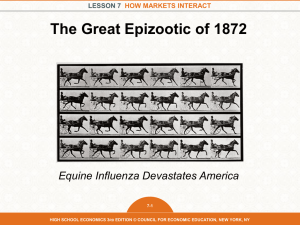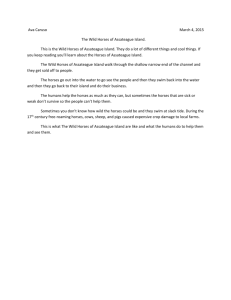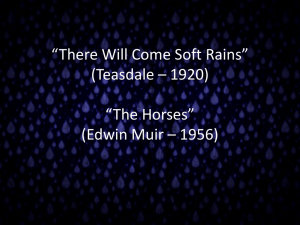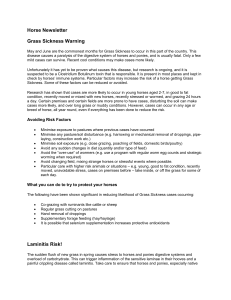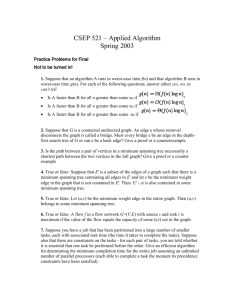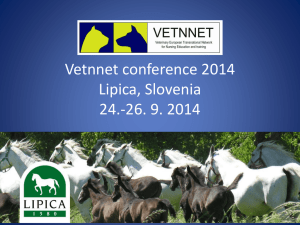The great epizootic of 1872
advertisement
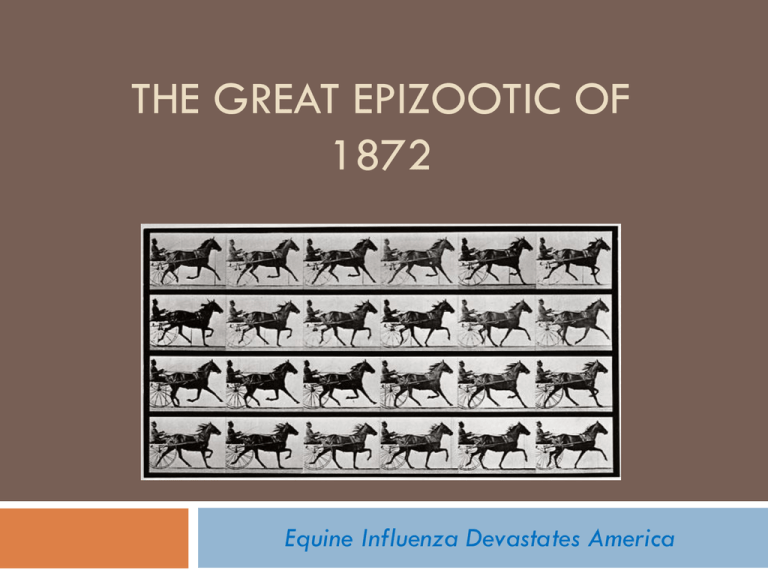
THE GREAT EPIZOOTIC OF 1872 Equine Influenza Devastates America AMERICA COMES TO A HALT Imagine a transportation disaster that within 90 days affected every aspect of American transportation, everything Americans took for granted, and everything that ensured their safety. AMERICA RAN ON HORSE POWER Throughout most of U.S. history, the horse has been the engine of business and commerce. Our nation relied on the gentle animal to move freight and perform countless tasks. Millions of horses 30 The horse population in the U.S. 25 20 15 10 5 0 1840 1850 1860 1870 1880 1890 1900 1910 1920 Horses per square mile New Orleans Atlanta Washington Baltimore Philadelphia New York Buffalo Albany Boston Kansas City Milwaukee Cincinnati Detroit Chicago 0 200 400 600 800 9/25-Markham, Ont. 10/1- Toronto 10/10-Detroit 10/14- Buffalo, NY 10/17-Rochester, NY 10/18- Montreal 10/19- Syracuse, NY 10/21- Keene, NH 10/22- NY, NY 10/22- Boston 10/23- Bangor, Me 10/23- Chicago 10/24- Baltimore 10/26- Pontiac, Mi 10/28- Philadelphia 10/28- Wash D.C. 10/29-Columbus, OH 11/1- Newark, De 11/2- Charleston 11/4- Springfield, Ill 11/5-Grand Rapids 11/6- Richmond, Va 11/10- Indianapolis 11/10-Savannah 11/13- Louisville 11/27- New Orleans 12/1-Colorado Springs 12/7-Havana, Cuba 1/26-Albuquerque A highly contagious strain of equine influenza originated in Toronto, Canada and swept south into the US in late 1872, affecting the entire country within 90 days. It is estimated that 80%-99% of horses were eventually infected. Horses were unable to stand in their stables and were seen coughing violently in the streets. AMERICA CAME TO A STANDSTILL The government in Washington D.C. was shut down Ships in New York harbor could not unload their cargo A small fire in Boston grew into a devastating inferno destroying a large amount of the city The U.S. Cavalry was forced to fight the Apaches on foot EVERYDAY LIFE WAS FROZEN In Philadelphia, streetcar companies suspended service undelivered freight accumulated at wharves and railroad depots consumers lacked milk, ice and groceries saloons lacked beer work halted at construction sites, brickyards and factories city governments curtailed fire protection and garbage collection. ISOLATING DIDN’T HELP While the mortality rate was relatively low, estimated at only 1%-2% overall, large cities lost many more horses than in rural areas. Since there were no horses to haul coal out of mines, many railroads went bankrupt as well as thousands of other businesses. NEWSPAPER REPORTS Reporting in the New York Times gives an insight into the extent of the outbreak. "There is hardly a public stable in the city which is not affected“. the paper reported on October 24, 1872. "It is not uncommon along the streets of the city to see horses dragging along with drooping heads and at intervals coughing violently." "Large quantities of freight are accumulating along the Erie Railway in Paterson, New Jersey. “The disease is spreading rapidly in Bangor, Maine. All fire department horses in Providence, Rhode Island, are sick." THE FATE OF THE ECONOMY WAS IN JEOPARDY It was becoming apparent that a nation so heavily dependent on the horse for so much could suffer an economic calamity from this epidemic. Remember, this disease began spreading in the fall of 1872. What are most farmers doing in the fall of every year? How do Midwestern crops get to Eastern cities? What impact would this event have on your ability to buy food for your family? GREAT BOSTON FIRE OF 1872 One of the major casualties of the Great Epizootic was the city of Boston itself. A great fire swept through the industrial section on November 9, ultimately destroying 65 acres of the city, comprising 776 buildings. No one is certain how the fire started. The water supply in the area was inadequate, and many of the buildings had wooden roofs and were filled with flammable materials. Citizens of Boston were forced to haul water to the location on foot, without the assistance of heavy, faster-moving horses. THE LACK OF HORSES AFFECTED THE OUTCOME OF THE APACHE WAR "There was still another source of discomfort which should not be overlooked. At that time the peculiar disease known as the epizootic made its appearance in the United States and reached Arizona, crippling the resources of the Department in horses and mules; we had to abandon our animals, and take our rations and blanket upon our backs, and do the best we could“. The Chiricahua Apache chief, Cochise, was a famous mounted guerrilla. Captain John Bourke 1891 SUPPLY & DEMAND THE IMPACT ON PRICES Consumers “willingness to buy” Price decreases; QD increases P QD $5 4 3 2 1 10 20 35 55 80 $5 D $4 $3 $2 $1 0 10 20 35 55 80 Quantity Demanded …a specified time period …other things being equal QD – how much will be purchased at a specific price [& date]. . Price increases; QS increases Price decreases; QS decreases Direct “S” refers to the “whole supply curve” and refers to what producers will supply at “different prices”. “QS” refers to a “point on the curve” and refers to what producers will supply at a “particular price”. S Change in “QS” P2 1. Price change 2. Movement (up/down “S” curve) P1 3. Point to point (along “S” curve) Producers want the highest price possible. QS1 QS2 Reasons For Upsloping “S” Curve 1. There is increasing opportunity cost if you don’t produce. 2. Current producers produce more [overtime/more shifts] 3. New producers are attracted to the market. GRAPHING DEMAND [Change in QD] Price of Corn P CORN P $5 4 3 2 1 QD 10 20 35 50 70 $5 Connect the Points 4 3 2 1 o D 10 20 30 40 50 60 70 80 Quantity of Corn Q Price of Corn $5 S $4 $3 Plot the Points $2 $1 o Connect the Points 10 20 30 40 50 60 70 80 Quantity of Corn CORN P $5 4 3 2 1 Q QS 60 50 35 20 5 Price (per pound) Banana Supply & Demand P D1 S1 Crop Freezing S2 Damage… P2 P1 o Q2 Q1 Quantity Q American Flags After 9-11 P D1 D2 S1 Price (per flag) P2 P1 o Q1 Q2 Q Patriotism Surge after 9/11…

